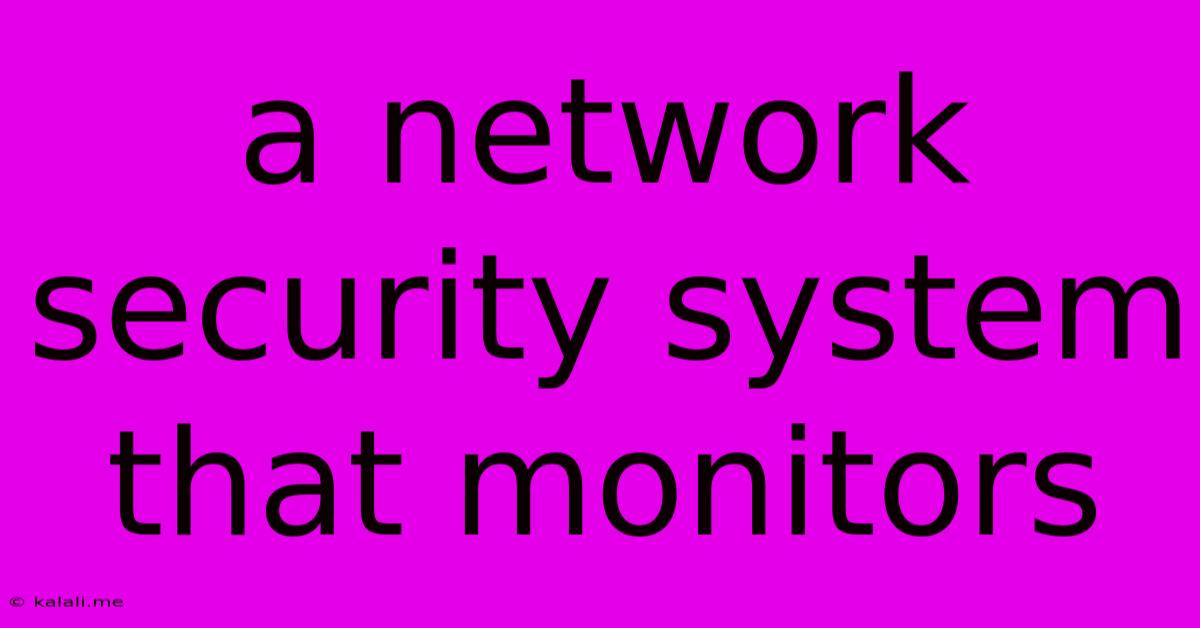A Network Security System That Monitors
Kalali
Jun 12, 2025 · 3 min read

Table of Contents
A Network Security System That Monitors: Protecting Your Digital Assets in the Modern Age
Meta Description: Learn about advanced network security systems that actively monitor your network for threats, intrusions, and vulnerabilities. Discover key features, benefits, and considerations for choosing the right system for your needs.
The digital landscape is constantly evolving, presenting increasingly sophisticated cyber threats. A robust network security system is no longer a luxury—it's a necessity. This article dives into the critical role of a network security system that actively monitors your network, highlighting key features and considerations for effective protection. We'll explore how these systems provide a crucial layer of defense against a wide range of attacks, from malware infections to data breaches.
Understanding the Importance of Network Monitoring
In today's interconnected world, your network is a valuable asset, containing sensitive data, critical applications, and intellectual property. A comprehensive network security system, with its monitoring capabilities, acts as a vigilant guardian, constantly scanning for suspicious activity and potential threats. This proactive approach allows for early detection and rapid response, minimizing the impact of security incidents. Key benefits include:
- Early Threat Detection: Real-time monitoring identifies anomalies and potential breaches before they escalate into major incidents.
- Reduced Downtime: Faster identification and response to attacks minimizes service disruptions and operational downtime.
- Improved Compliance: Many industry regulations require organizations to demonstrate robust security measures. A monitored network security system helps meet these compliance requirements.
- Data Protection: Effective monitoring safeguards sensitive data from unauthorized access and theft.
- Enhanced Reputation: Demonstrating a commitment to robust cybersecurity builds trust with customers and partners.
Core Features of a Monitoring Network Security System
A sophisticated network security system incorporates several key monitoring features:
- Intrusion Detection and Prevention Systems (IDPS): These systems analyze network traffic for malicious patterns and either alert administrators (IDS) or automatically block suspicious activity (IPS). They are crucial for identifying and mitigating attacks like DDoS (Distributed Denial of Service) attacks and unauthorized access attempts.
- Security Information and Event Management (SIEM): SIEM solutions collect and analyze security logs from various sources across the network, providing a centralized view of security events. This allows for correlation of events, identification of trends, and faster response to incidents.
- Vulnerability Scanning: Regularly scanning for known vulnerabilities in software and hardware is critical. This proactive approach identifies weaknesses before attackers can exploit them.
- Network Behavior Analysis (NBA): NBA uses machine learning and AI to establish a baseline of "normal" network behavior. Deviations from this baseline trigger alerts, highlighting potential threats.
- Endpoint Detection and Response (EDR): EDR solutions monitor endpoints (computers, servers, mobile devices) for malicious activity, providing detailed insights into attacks and enabling rapid response.
Choosing the Right Network Security System
Selecting the right system depends on several factors:
- Network Size and Complexity: Larger and more complex networks require more sophisticated systems with greater scalability.
- Budget: Network security systems range in price, from basic solutions to enterprise-grade platforms.
- Industry Regulations: Compliance with industry-specific regulations (e.g., HIPAA, PCI DSS) dictates certain security requirements.
- Technical Expertise: The level of technical expertise within the organization impacts the choice of system and its management.
Conclusion
A network security system that actively monitors your network is paramount in today's threat landscape. By implementing a robust system incorporating the features discussed above, organizations can significantly reduce their risk of cyberattacks, protect valuable assets, and maintain business continuity. The investment in a strong monitoring system is an investment in the long-term security and stability of your digital infrastructure. Regular updates, thorough testing, and ongoing monitoring are essential to ensure the effectiveness of your security measures.
Latest Posts
Latest Posts
-
Marketing A Service Vs Marketing A Product
Jun 13, 2025
-
Average Sat Score For University Of Delaware
Jun 13, 2025
-
A Tachometer Is Used To Measure
Jun 13, 2025
-
Which Shape Has Exactly 1 Line Of Symmetry
Jun 13, 2025
-
How Many People Are On The Court In Basketball
Jun 13, 2025
Related Post
Thank you for visiting our website which covers about A Network Security System That Monitors . We hope the information provided has been useful to you. Feel free to contact us if you have any questions or need further assistance. See you next time and don't miss to bookmark.